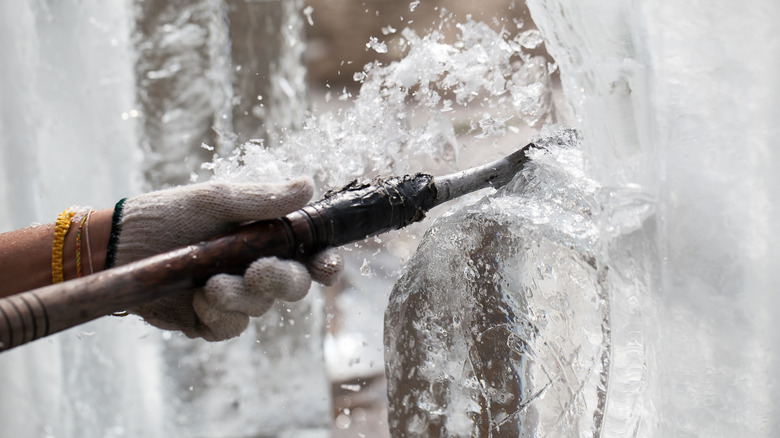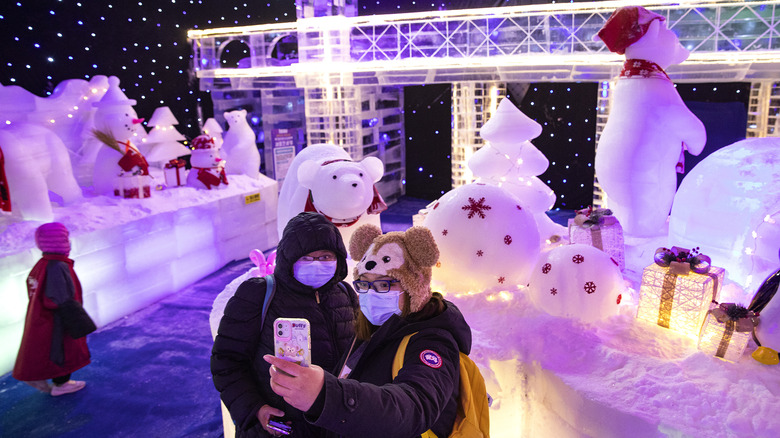Where Did Ice Sculpting Originate?
The oldest-surviving works of art are probably cave paintings, and specifically, according to Artnet, a handful of cave paintings in Indonesia, dating back 45,000 years. The prehistoric humans might not have intended their artwork to last 45 millennia — heck, they may not have even been able to grasp the concept of 45 millennia. Tens of thousands of years later, when Michelangelo painted the ceiling of the Sistine Chapel, he almost certainly expected — or at least, hoped — that his work would survive the next several centuries.
All of this is to say that art is, ideally anyway, intended to last. Few artists will compose a work knowing that it has a finite timespan that can be measured in months, hours, or even seconds. There are exceptions, however: For example, some Buddhist monks painstakingly create sand mandalas — impossibly-intricate compositions made of, well, colored sand — and then immediately destroy them upon completion, as a metaphor for the transitory nature of the universe and the things within it.
Another form of art with an intentionally short lifespan (hours or, in some conditions, months) is ice sculpting. And there are actually two ways to look at ice sculpting: the decorative, culinary version, such as an ice swan that adorns a buffet table on a cruise ship; and outdoor creations in colder climates, oft absorbed into festivals that are also tourist attractions.
Outdoor Ice Sculpting Goes Back Centuries
Humans have been carving structures out of ice — for shelter, for food storage, etc. — for a long time, according to VUE New Jersey. By the 1600s, fishermen in Harbin, China had started the practice of putting ice in buckets, carving holes in them, putting in candles, and effectively creating floating lanterns to guide the way. The practice spread to the townsfolk, who would often add subtle touches to their lanterns, and it eventually evolved to the point that Harbin began hosting an annual ice-carving festival that is, to this day, a major tourist attraction in China.
Such ice-sculpting festivals are now no longer limited to just China. As BBC Travel reports, ice-sculpting festivals are held in Canada, Estonia, and Japan, as well as Alaska and other places. It's in these events that some ice sculptors "go big or go home," as they say. Junichi Nakamura's team once created a porcupine-based sculpture with ice "quills" so thin the entire crowd was stunned that the entire thing didn't collapse. Other sculptors' pieces, however, have indeed collapsed.
Ice Sculpting In Cuisine And Hospitality
If you want to see an ice sculpture but don't have the budget to fly to a festival, just simply book a cruise. Or better yet, crash someone's wedding, or just go to a casino with a nice buffet. You're quite likely to see ice sculptures at any of those places, as ice sculpting has become part of the world of professional cuisine, according to Fresh Ideas Food. Per BBC Travel, culinary schools now include ice sculpting as part of their curricula.
How we got there is a bit of a journey. Writing in Fresh Ideas Food, Chef Jeremy Mattingly notes that, in the past, some chefs would put food on top of blocks of ice and then, later, would carve basic shapes. The practice would then evolve into the elaborate carving we know today.
How and when the practice officially began is difficult to nail down, but Priceonomics notes that, in 1892, French chef Auguste Escoffier sculpted an ice swan to accompany one of his desserts. Others followed suit. And of course, modern refrigeration methods mean that an ice sculpture can be carved more or less anywhere and at any time.


